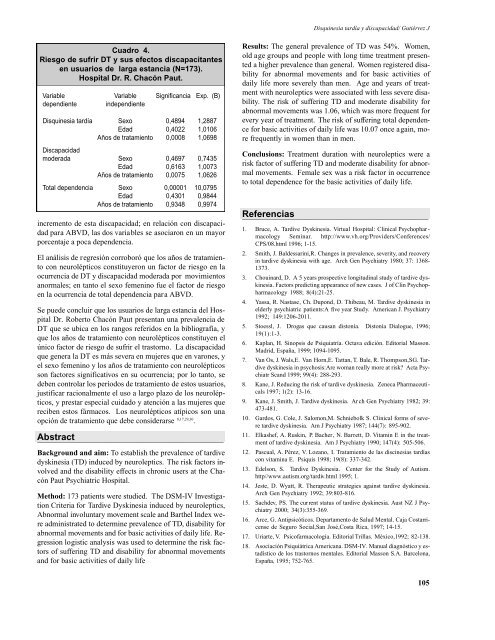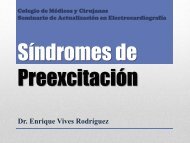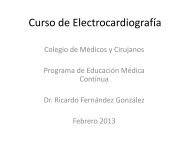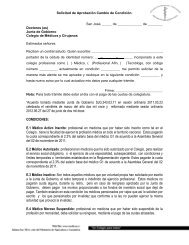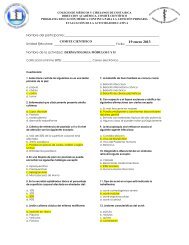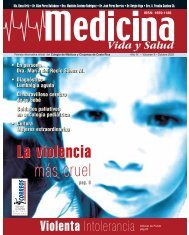Originales - Colegio de Médicos y Cirujanos de Costa Rica
Originales - Colegio de Médicos y Cirujanos de Costa Rica
Originales - Colegio de Médicos y Cirujanos de Costa Rica
You also want an ePaper? Increase the reach of your titles
YUMPU automatically turns print PDFs into web optimized ePapers that Google loves.
Cuadro 4.<br />
Riesgo <strong>de</strong> sufrir DT y sus efectos discapacitantes<br />
en usuarios <strong>de</strong> larga estancia (N=173).<br />
Hospital Dr. R. Chacón Paut.<br />
Variable Variable Significancia Exp. (B)<br />
<strong>de</strong>pendiente in<strong>de</strong>pendiente<br />
Disquinesia tardía Sexo 0,4894 1,2887<br />
Edad 0,4022 1,0106<br />
Años <strong>de</strong> tratamiento 0,0008 1,0698<br />
Discapacidad<br />
mo<strong>de</strong>rada Sexo 0,4697 0,7435<br />
Edad 0,6163 1,0073<br />
Años <strong>de</strong> tratamiento 0,0075 1,0626<br />
Total <strong>de</strong>pen<strong>de</strong>ncia Sexo 0,00001 10,0795<br />
Edad 0,4301 0,9844<br />
Años <strong>de</strong> tratamiento 0,9348 0,9974<br />
incremento <strong>de</strong> esta discapacidad; en relación con discapacidad<br />
para ABVD, las dos variables se asociaron en un mayor<br />
porcentaje a poca <strong>de</strong>pen<strong>de</strong>ncia.<br />
El análisis <strong>de</strong> regresión corroboró que los años <strong>de</strong> tratamiento<br />
con neurolépticos constituyeron un factor <strong>de</strong> riesgo en la<br />
ocurrencia <strong>de</strong> DT y discapacidad mo<strong>de</strong>rada por movimientos<br />
anormales; en tanto el sexo femenino fue el factor <strong>de</strong> riesgo<br />
en la ocurrencia <strong>de</strong> total <strong>de</strong>pen<strong>de</strong>ncia para ABVD.<br />
Se pue<strong>de</strong> concluir que los usuarios <strong>de</strong> larga estancia <strong>de</strong>l Hospital<br />
Dr. Roberto Chacón Paut presentan una prevalencia <strong>de</strong><br />
DT que se ubica en los rangos referidos en la bibliografía, y<br />
que los años <strong>de</strong> tratamiento con neurolépticos constituyen el<br />
único factor <strong>de</strong> riesgo <strong>de</strong> sufrir el trastorno. La discapacidad<br />
que genera la DT es más severa en mujeres que en varones, y<br />
el sexo femenino y los años <strong>de</strong> tratamiento con neurolépticos<br />
son factores significativos en su ocurrencia; por lo tanto, se<br />
<strong>de</strong>ben controlar los períodos <strong>de</strong> tratamiento <strong>de</strong> estos usuarios,<br />
justificar racionalmente el uso a largo plazo <strong>de</strong> los neurolépticos,<br />
y prestar especial cuidado y atención a las mujeres que<br />
reciben estos fármacos. Los neurolépticos atípicos son una<br />
opción <strong>de</strong> tratamiento que <strong>de</strong>be consi<strong>de</strong>rarse 8,17,29,30 .<br />
Abstract<br />
________________________________________________<br />
Background and aim: To establish the prevalence of tardive<br />
dyskinesia (TD) induced by neuroleptics. The risk factors involved<br />
and the disability effects in chronic users at the Chacón<br />
Paut Psychiatric Hospital.<br />
Method: 173 patients were studied. The DSM-IV Investigation<br />
Criteria for Tardive Dyskinesia induced by neuroleptics,<br />
Abnormal involuntary movement scale and Barthel In<strong>de</strong>x were<br />
administrated to <strong>de</strong>termine prevalence of TD, disability for<br />
abnormal movements and for basic activities of daily life. Regression<br />
logistic analysis was used to <strong>de</strong>termine the risk factors<br />
of suffering TD and disability for abnormal movements<br />
and for basic activities of daily life<br />
Disquinesia tardía y discapacidad/ Gutiérrez J<br />
Results: The general prevalence of TD was 54%. Women,<br />
old age groups and people with long time treatment presented<br />
a higher prevalence than general. Women registered disability<br />
for abnormal movements and for basic activities of<br />
daily life more severely than men. Age and years of treatment<br />
with neuroleptics were associated with less severe disability.<br />
The risk of suffering TD and mo<strong>de</strong>rate disability for<br />
abnormal movements was 1.06, which was more frequent for<br />
every year of treatment. The risk of suffering total <strong>de</strong>pen<strong>de</strong>nce<br />
for basic activities of daily life was 10.07 once again, more<br />
frequently in women than in men.<br />
Conclusions: Treatment duration with neuroleptics were a<br />
risk factor of suffering TD and mo<strong>de</strong>rate disability for abnormal<br />
movements. Female sex was a risk factor in occurrence<br />
to total <strong>de</strong>pen<strong>de</strong>nce for the basic activities of daily life.<br />
Referencias<br />
________________________________________________<br />
1. Bruce, A. Tardive Dyskinesia. Virtual Hospital: Clinical Psychophar -<br />
m a c o l ogy Seminar. http://www. v h . o rg / P rov i d e rs / C o n fe re n c e s /<br />
CPS/08.html 1996; 1-15.<br />
2. Smith, J. Bal<strong>de</strong>ssarini,R. Changes in prevalence, severity, and recovery<br />
in tardive dyskinesia with age. Arch Gen Psychiatry 1980; 37: 1368-<br />
1373.<br />
3. Chouinard, D. A 5 years prospective longitudinal study of tardive dyskinesia.<br />
Factors predicting appearance of new cases. J of Clin Psychopharmacology<br />
1988; 8(4):21-25.<br />
4. Yassa, R. Nastase, Ch. Dupond, D. Thibeau, M. Tardive dyskinesia in<br />
el<strong>de</strong>rly psychiatric patients:A five year Study. American J. Psychiatry<br />
1992; 149:1206-2011.<br />
5. Stoessl, J. Drogas que causan distonía. Distonía Dialogue, 1996;<br />
19(1):1-3.<br />
6. Kaplan, H. Sinopsis <strong>de</strong> Psiquiatría. Octava edición. Editorial Masson.<br />
Madrid, España, 1999; 1094-1095.<br />
7. Van Os, J. Wals,E. Van Horn,E. Tattan, T. Bale, R. Thompson,SG. Tardive<br />
dyskinesia in psychosis:Are woman really more at risk? Acta Psychiatr<br />
Scand 1999; 99(4): 288-293.<br />
8. Kane, J. Reducing the risk of tardive dyskinesia. Zeneca Pharmaceuticals<br />
1997; 1(2): 13-16.<br />
9. Kane, J. Smith, J. Tardive dyskinesia. Ar ch Gen Psychiatry 1982; 39:<br />
473-481.<br />
10. Gardos, G. Cole, J. Salomon,M. Schniebolk S. Clinical forms of severe<br />
tardive dyskinesia. Am J Psychiatry 1987; 144(7): 895-902.<br />
11. Elkashef, A. Ruskin, P. Bacher, N. Barrett, D. Vitamin E in the treatment<br />
of tardive dyskinesia. Am J Psychiatry 1990; 147(4): 505-506.<br />
12. Pascual, A. Pérez, V. Lozano, I. Tratamiento <strong>de</strong> las discinesias tardías<br />
con vitamina E. Psiquis 1998; 19(8): 337-342.<br />
13. E<strong>de</strong>lson, S. Tardive Dyskinesia. Center for the Study of Autism.<br />
http//www.autism.org/tardiv.html 1995; 1.<br />
14. Jeste, D. Wyatt, R. Therapeutic strategies against tardive dyskinesia.<br />
Arch Gen Psychiatry 1992; 39:803-816.<br />
15. Sach<strong>de</strong>v, PS. The current status of tardive dyskinesia. Aust NZ J Psychiatry<br />
2000; 34(3):355-369.<br />
16. Arce, G. Antipsicóticos. Departamento <strong>de</strong> Salud Mental. Caja <strong>Costa</strong>rricense<br />
<strong>de</strong> Seguro Social,San José,<strong>Costa</strong> <strong>Rica</strong>, 1997; 14-15.<br />
17. Uriarte, V. Psicofarmacología. Editorial Trillas. México,1992; 82-138.<br />
18. Asociación Psiquiátrica Americana. DSM-IV. Manual diagnóstico y estadístico<br />
<strong>de</strong> los trastornos mentales. Editorial Masson S.A. Barcelona,<br />
España, 1995; 752-765.<br />
105


